|
January 2010 Celestial Events & Space Research News
January 2010 SkyMaps and Sky Guides NOT AVAILABLE UNTIL January 1st
January 2010 –
SkyMaps & Celestial Guides
……………………………………………………..
Astronomy Today Sky Guide – January 2010
Night Sky – January
January 01 2010 –
Today’s Celestial Events & Space Exploration News
……………………
Astronomy Picture of the Day
Daily Sunspot Number for last 24 hours: 18
NOAA Space Weather Prediction Center
The Australian Space Weather Agency
Comet C/2009 O4 (Hill) –
Perihelion (2.564 AU)
Asteroid 25143 Itokawa –
Closest Approach To Earth (0.571 AU)
Asteroid 6984 Lewiscarroll Closest Approach To Earth (2.306 AU)
January 02 2010 –
Today’s Celestial Events & Space Exploration News
……………………
Astronomy Picture of the Day
Daily Sunspot Number for last 24 hours: 16
NOAA Space Weather Prediction Center
The Australian Space Weather Agency
New Year’s Eve Blue Moon Eclipse Gallery
Comet 118P/Shoemaker-Levy 4 –
Perihelion (1.984 AU)
Asteroid 9342 Carygrant Closest Approach To Earth (1.350 AU)
“The Ten Centimetre Solar Radio Flux”
January 03 2010 – 00:00 UT –
Earth at Perihelion
(closest to the Sun)
January 03 2010 –
Today’s Celestial Events & Space Exploration News
……………………
Astronomy Picture of the Day
Daily Sunspot Number for last 24 hours: 22
NOAA Space Weather Prediction Center
The Australian Space Weather Agency
Asteroid 6524 Baalke Closest Approach To Earth (1.252 AU)
“Editorial: Risk of Apophis”
“Sungrazing Comet Alert”
January 03/04 2010 –
Today’s Celestial Events & Space Exploration News
……………….
Quadrantids (QUA) Meteor Shower Peak
January 04 2010 –
Today’s Celestial Events & Space Exploration News
……………………
Astronomy Picture of the Day
Daily Sunspot Number for last 24 hours: 20
NOAA Space Weather Prediction Center
The Australian Space Weather Agency
“Kepler Discovers Five New Exoplanets”
“Spectacular Mars images reveal evidence of ancient lakes”
“Nasa’s Kepler planet-hunter detects five worlds”
January 05 2010 –
Today’s Celestial Events & Space Exploration News
……………………
Astronomy Picture of the Day
Daily Sunspot Number for last 24 hours: 15
NOAA Space Weather Prediction Center
The Australian Space Weather Agency
Comet 82P/Gehrels 3 –
Closest Approach To Earth (2.650 AU)
Asteroid 1069 Planckia Closest Approach To Earth (2.047 AU)
Asteroid 8000 Isaac Newton Closest Approach To Earth (2.333 AU)
Asteroid 2404 Antarctica Closest Approach To Earth (2.520 AU)
“Ancient Mars Had Liquid Lakes”
January 05-08 2010 –
Today’s Celestial Events & Space Exploration News
……………….
Gamma Velids Meteor Shower Peak
January 06 2010 –
Today’s Celestial Events & Space Exploration News
……………………
Astronomy Picture of the Day
Daily Sunspot Number for last 24 hours: 13
NOAA Space Weather Prediction Center
The Australian Space Weather Agency
January 2010 Northern Lights Gallery
Comet P/2005 S2 (Skiff) –
Closest Approach To Earth (6.374 AU)
Asteroid 9963 Sandage Closest Approach To Earth (1.473 AU)
Asteroid 2305 King Closest Approach To Earth (1.807 AU)
Asteroid 3784 Chopin Closest Approach To Earth (2.673 AU)
“NASA scientist’s experiment to find out if Mars ever had life in the past”
“The Mystery Of The Missing Spike In The Galaxy Arp 192”
January 07 2010 – 10:39 UT –
End of Third Lunar Quarter
January 07 2010 –
Today’s Celestial Events & Space Exploration News
……………………
Astronomy Picture of the Day
Daily Sunspot Number for last 24 hours: 0
NOAA Space Weather Prediction Center
The Australian Space Weather Agency
400th Anniversary (1610) of Galileo Galilei’s Discovery of Jupiter’s Moons
“Super-Earth ‘began as gas giant'”
“Why Won’t the Supernova Explode?”
January 08 2010 –
Today’s Celestial Events & Space Exploration News
……………………
Astronomy Picture of the Day
Daily Sunspot Number for last 24 hours: 15
NOAA Space Weather Prediction Center
The Australian Space Weather Agency
Asteroid 2005 YO3 Near-Earth Flyby (0.095 AU)
Asteroid 12382 Niagara Falls Closest Approach To Earth (1.922 AU)
January 08/09 2010 –
Today’s Celestial Events & Space Exploration News
……………….
Rho Geminids Meteor Shower Peak
January 09 2010 –
Today’s Celestial Events & Space Exploration News
……………………
Astronomy Picture of the Day
Daily Sunspot Number for last 24 hours: 14
NOAA Space Weather Prediction Center
The Australian Space Weather Agency
January 10 2010 –
Today’s Celestial Events & Space Exploration News
……………………
Astronomy Picture of the Day
Daily Sunspot Number for last 24 hours: 15
NOAA Space Weather Prediction Center
The Australian Space Weather Agency
Asteroid 10221 Kubrick Closest Approach To Earth (1.373 AU)
January 11 2010 –
Today’s Celestial Events & Space Exploration News
……………………
Astronomy Picture of the Day
Daily Sunspot Number for last 24 hours: 25
NOAA Space Weather Prediction Center
The Australian Space Weather Agency
Cassini, Distant Flyby of Pandora & Methone
Asteroid 24761 Ahau flyby – miss distance 70.8 LD, magnitude 16, size = 1.4 Km
Asteroid 2010 AL2 flyby – miss distance 11.5 LD, magnitude 20, size = 23m
January 12 2010 –
Today’s Celestial Events & Space Exploration News
……………………
Astronomy Picture of the Day
Daily Sunspot Number for last 24 hours: 35
NOAA Space Weather Prediction Center
The Australian Space Weather Agency
Cassini, Titan Flyby
Comet 169P/NEAT –
Near-Earth Flyby (0.194 AU)
Comet C/2009 O4 (Hill) –
Perihelion (2.564 AU)
As of today there are 1092 known Potentially Hazardous Asteroids
Asteroid 2000 YH66 flyby – miss distance 69.5 LD, magnitude 17, size = 1.1 Km
Asteroid 25143 Itokawa –
Closest Approach To Earth (0.571 AU)
“Nasa check for ‘unlikely’ survival of Mars lander”
“Partial Solar Eclipse visible from South Africa on 15th of January”
“The cosmos cycles on…”
January 13 2010 –
Today’s Celestial Events & Space Exploration News
……………………
Astronomy Picture of the Day
Daily Sunspot Number for last 24 hours: 35
NOAA Space Weather Prediction Center
The Australian Space Weather Agency
Comet P/2005 JQ5 (Catalina) –
Closest Approach To Earth (1.659 AU)
Asteroid 2010 AL30 flyby – miss distance 0.3 LD, magnitude 14, size = 18m
Asteroid 9885 Linux Closest Approach To Earth (1.237 AU)
Asteroid 3350 Scobee Closest Approach To Earth (1.715 AU)
Asteroid 2421 Nininger Closest Approach To Earth (2.334 AU)
January 13-16 2010 –
Today’s Celestial Events & Space Exploration News
……………….
January Draconids Meteor Shower Peak
January 14 2010 –
Today’s Celestial Events & Space Exploration News
……………………
Astronomy Picture of the Day
Daily Sunspot Number for last 24 hours: 35
NOAA Space Weather Prediction Center
The Australian Space Weather Agency
Asteroid 1134 Kepler Closest Approach To Earth (2.444 AU)
“AstroBlog: In The Sky This Week – Southern Hemisphere”
“Alien Planet Safari”
“Big Aussie Star Hunt: Summer sky tour”
January 15 2010 – 07:11 UT –
New Moon
Annular Solar Eclipse 05:00 to 09:00
– visible in Africa, India & China –
January 15 2010 –
Today’s Celestial Events & Space Exploration News
……………………
Astronomy Picture of the Day
Daily Sunspot Number for last 24 hours: 34
NOAA Space Weather Prediction Center
The Australian Space Weather Agency
Animated image of Annular Solar Eclipse – visible in Africa, India & China
Incoming eclipse images from Oleg Toumilovitch of Blairgowrie, South Africa
Asteroid 9000 Hal Closest Approach To Earth (1.707 AU)
“Herschel space telescope restored to full health”
“Giant Ribbon at the Edge of the Solar System: Mystery Solved?”
January 16 2010 –
Today’s Celestial Events & Space Exploration News
……………………
Astronomy Picture of the Day
Daily Sunspot Number for last 24 hours: 26
NOAA Space Weather Prediction Center
The Australian Space Weather Agency
Comet C/2009 Q4 (Boattini) –
Closest Approach To Earth (0.581 AU)
Asteroid 29075 (1950 DA) –
Closest Approach To Earth (0.901 AU)
“Longest solar eclipse for 1,000 years turns Sun into a blazing ring of fire”
January 16/17 2010 –
Today’s Celestial Events & Space Exploration News
……………….
Eta Craterids Meteor Shower Peak
January 16-18 2010 –
Today’s Celestial Events & Space Exploration News
……………….
January Boötids Meteor Shower Peak
January 17 2010 –
Today’s Celestial Events & Space Exploration News
……………………
Astronomy Picture of the Day
Daily Sunspot Number for last 24 hours: 24
NOAA Space Weather Prediction Center
The Australian Space Weather Agency
Comet 64P/Swift-Gehrels –
Closest Approach To Earth (1.822 AU)
Asteroid 2009 DA43 Near-Earth Flyby (0.092 AU)
Asteroid 5554 Keesey Closest Approach To Earth (1.235 AU)
Asteroid 35352 Texas Closest Approach To Earth (1.917 AU)
Asteroid 13681 Monty Python Closest Approach To Earth (2.194 AU)
January 17 2010 –
Today’s Celestial Events & Space Exploration News
……………………
Delta Cancrids (DCA) Meteor Shower Peak
January 18 2010 –
Today’s Celestial Events & Space Exploration News
……………………
Astronomy Picture of the Day
Daily Sunspot Number for last 24 hours: 16
NOAA Space Weather Prediction Center
The Australian Space Weather Agency
Asteroid 2008 XM Near-Earth Flyby (0.079 AU)
January 19 2010 –
Today’s Celestial Events & Space Exploration News
……………………
Astronomy Picture of the Day
Daily Sunspot Number for last 24 hours: 14
NOAA Space Weather Prediction Center
As of today there are 1093 known Potentially Hazardous Asteroids
Asteroid 2010 AG3 flyby – miss distance 8.9 LD, magnitude 21, size = 14m
Asteroid 2010 AN61 flyby – miss distance 8.0 LD, magnitude 20, size = 17m
“Herschel readies itself for the Orion Nebula”
January 20 2010 –
Today’s Celestial Events & Space Exploration News
……………………
Astronomy Picture of the Day
Daily Sunspot Number for last 24 hours: 0
NOAA Space Weather Prediction Center
The Australian Space Weather Agency
Asteroid 11714 Mikebrown Closest Approach To Earth (2.347 AU)
“Portuguese Students Get A Glimpse Into Future Mars Missions”
“Esa mission concepts vie for position”
January 20/21 2010 –
Today’s Celestial Events & Space Exploration News
……………….
Alpha Hydrids Meteor Shower Peak
January 21 2010 –
Today’s Celestial Events & Space Exploration News
……………………
Astronomy Picture of the Day
Daily Sunspot Number for last 24 hours: 16
NOAA Space Weather Prediction Center
The Australian Space Weather Agency
January 2010 Northern Lights Gallery
Asteroid 2010 AF40 flyby – miss distance 2.3 LD, magnitude 16, size = 43m
“No word from Phoenix Mars lander; scientists say it may not have survived winter”
“Meteorite colour mystery ‘solved'”
January 21/22 2010 –
Today’s Celestial Events & Space Exploration News
……………….
Eta Carinids Meteor Shower Peak
January 22 2010 –
Today’s Celestial Events & Space Exploration News
……………………
Astronomy Picture of the Day
Daily Sunspot Number for last 24 hours: 16
NOAA Space Weather Prediction Center
The Australian Space Weather Agency
Asteroid 2003 BH Near-Earth Flyby (0.091 AU)
Asteroid 7672 Hawking Closest Approach To Earth (1.226 AU)
Asteroid 12574 LONEOS Closest Approach To Earth (1.493 AU)
Asteroid 7231 Porco Closest Approach To Earth (2.390 AU)
“Congo receives help from space after volcano eruption”
January 23 2010 – 10:53 UT –
End of First Lunar Quarter
January 23 2010 –
Today’s Celestial Events & Space Exploration News
……………………
Astronomy Picture of the Day
Daily Sunspot Number for last 24 hours: 30
NOAA Space Weather Prediction Center
The Australian Space Weather Agency
“The Story of an Astrophoto”
January 24 2010 –
Today’s Celestial Events & Space Exploration News
……………………
Astronomy Picture of the Day
Daily Sunspot Number for last 24 hours: 30
NOAA Space Weather Prediction Center
The Australian Space Weather Agency
As of today there are 1094 known Potentially Hazardous Asteroids
Asteroid 2010 BC flyby – miss distance 7.6 LD, magnitude 16, size = 160m
January 24/25 2010 –
Today’s Celestial Events & Space Exploration News
……………….
Canids Meteor Shower Peak
January 24-31 2010 –
Today’s Celestial Events & Space Exploration News
……………….
Alpha Leonids Meteor Shower Peak
January 25 2010 –
Today’s Celestial Events & Space Exploration News
……………………
Astronomy Picture of the Day
Daily Sunspot Number for last 24 hours: 32
NOAA Space Weather Prediction Center
The Australian Space Weather Agency
Asteroid 9949 Brontosaurus Closest Approach To Earth (1.357 AU)
“Comets ‘Melted’ Jupiter’s Biggest Moon”
January 26 2010 –
Today’s Celestial Events & Space Exploration News
……………………
Astronomy Picture of the Day
Daily Sunspot Number for last 24 hours: 34
NOAA Space Weather Prediction Center
The Australian Space Weather Agency
Asteroid 2198 Ceplecha Closest Approach To Earth (1.490 AU)
“NASA Mars Rover Spirit ends one mission to start another”
“Cosmologist Andrew Lange Remembered”
“Spirit is Now a Stationary Science Platform”
“Planet Definition Doesn’t Apply Beyond the Solar System”
January 27 2010 –
Today’s Celestial Events & Space Exploration News
……………………
Astronomy Picture of the Day
Daily Sunspot Number for last 24 hours: 28
NOAA Space Weather Prediction Center
The Australian Space Weather Agency
Cassini, Distant Flyby of Dione, Telesto, Methone, Pan & Prometheus
Mercury –
At Its Greatest Western Elongation (25 Degrees)
Today Earth and Mars will be just 61.5 million miles apart – closest until 2012
Asteroid 2010 BU2 flyby – miss distance 6.4 LD, magnitude 17, size = 52m
Asteroid 3768 Monroe Closest Approach To Earth (2.357 AU)
“Major Galileo contracts signed”
January 28 2010 –
Today’s Celestial Events & Space Exploration News
……………………
Astronomy Picture of the Day
Daily Sunspot Number for last 24 hours: 15
NOAA Space Weather Prediction Center
The Australian Space Weather Agency
Cassini, Titan Flyby
Mars Closest Approach To Earth (0.664 AU)
Comet C/2009 U6 (LINEAR) –
Closest Approach To Earth (1.371 AU)
Asteroid 293 Brasilia Closest Approach To Earth (1.637 AU)
Asteroid 14702 Benclark Closest Approach To Earth (2.323 AU)
Asteroid 37452 Spirit Closest Approach To Earth (2.830 AU)
“Big Aussie Starhunt: Summer Sky Tour – S. Hemisphere Only”
January 29 2010 –
Today’s Celestial Events & Space Exploration News
……………………
Astronomy Picture of the Day
Daily Sunspot Number for last 24 hours: 15
NOAA Space Weather Prediction Center
The Australian Space Weather Agency
Mars –
At Opposition
Comet P/1998 VS24 (LINEAR) –
Closest Approach To Earth (3.286 AU)
Asteroid 6775 Giorgini Closest Approach To Earth (2.112 AU)
“Firefly Mission to Study Terrestrial Gamma-ray Flashes”
“Solar eclipse seen from space”
January 30 2010 – 06:18 UT –
Full Wolf Moon
January 30 2010 –
Today’s Celestial Events & Space Exploration News
……………………
Astronomy Picture of the Day
Daily Sunspot Number for last 24 hours: 12
NOAA Space Weather Prediction Center
The Australian Space Weather Agency
Asteroid 2008 CN1 Near-Earth Flyby (0.095 AU)
January 31 2010 –
Today’s Celestial Events & Space Exploration News
……………………
Astronomy Picture of the Day
Daily Sunspot Number for last 24 hours: 25
NOAA Space Weather Prediction Center
The Australian Space Weather Agency
Comet 224P/LINEAR-NEAT –
Perihelion (1.990 AU)
“Chiyli Crater, Kazakhstan”
“Obama to revise Nasa space vision”
You Can Help To Support This Free Service
If You Buy Your Books About:
Comets & Cometary Debris , ,
Asteroids , ,
Meteors & Meteor Showers
Impact Craters , ,
Meteorites and and
General Astronomy
From These Links Provided By
The Morien Institute
Free Open Source Planetarium
For Your Computer
– Enjoy –
February 2010 Celestial Events & Space Research News
February 2010 SkyMaps and Sky Guide NOT AVAILABLE UNTIL February 1st
February 2010 –
SkyMaps & Celestial Guides
…………………………………………………….
Astronomy Today Sky Guide – February 2010
Night Sky – February
February 01 2010 –
Today’s Celestial Events & Space Exploration News
…………………..
Astronomy Picture of the Day
Daily Sunspot Number for last 24 hours: 14
NOAA Space Weather Prediction Center
The Australian Space Weather Agency
Asteroid 9937 Triceratops Closest Approach To Earth (1.588 AU)
“Glacier-melting debate highlights importance of satellites”
“Earthly meltdown formed the Moon: study”
“Fears of cataclysm prompt more research into asteroids”
February 02 2010 –
Today’s Celestial Events & Space Exploration News
…………………..
Astronomy Picture of the Day
Daily Sunspot Number for last 24 hours: 16
NOAA Space Weather Prediction Center
The Australian Space Weather Agency
Comet C/2007 Q3 (Siding Spring) –
Closest Approach To Earth (2.193 AU)
“Hubble Sees Suspected Asteroid Collision”
February 03 2010 –
Today’s Celestial Events & Space Exploration News
…………………..
Astronomy Picture of the Day
Daily Sunspot Number for last 24 hours: 11
NOAA Space Weather Prediction Center
The Australian Space Weather Agency
February 2010 Northern Lights Gallery
Asteroid 1862 Apollo –
Closest Approach To Earth (1.306 AU)
Asteroid 2008 CD119 Near-Earth Flyby (0.072 AU)
Asteroid 9770 Discovery Closest Approach To Earth (1.167 AU)
Asteroid 12820 Robinwilliams Closest Approach To Earth (2.009 AU)
“Exoplanet gas spotted from Earth”
“Craters young and old in Sirenum Fossae”
“Suspected Asteroid Collision Leaves Trailing Debris”
February 04 2010 –
Today’s Celestial Events & Space Exploration News
…………………..
Astronomy Picture of the Day
Daily Sunspot Number for last 24 hours: 11
NOAA Space Weather Prediction Center
The Australian Space Weather Agency
Comet C/2009 U5 (Grauer) –
Closest Approach To Earth (5.171 AU)
Asteroid 2008 CL20 Near-Earth Flyby (0.059 AU)
Asteroid 2001 UF18 Near-Mercury Flyby (0.026 AU)
“Tycho Brahe to be exhumed”
“Heavenly hounds appear in February sky”
February 05 2010 – 23:48 UT –
End of Third Lunar Quarter
February 05 2010 –
Today’s Celestial Events & Space Exploration News
…………………..
Astronomy Picture of the Day
Daily Sunspot Number for last 24 hours: 12
NOAA Space Weather Prediction Center
The Australian Space Weather Agency
“Hubble zooms in on head-on asteroid crash”
“Solar Dynamics Observatory: The ‘Variable Sun’ Mission”
February 05-10 2010 –
Today’s Celestial Events & Space Exploration News
………………
Aurigids Meteor Shower Peak
February 06 2010 –
Today’s Celestial Events & Space Exploration News
…………………..
Astronomy Picture of the Day
Daily Sunspot Number for last 24 hours: 22
NOAA Space Weather Prediction Center
The Australian Space Weather Agency
Asteroid 2001 SF286 Near-Mercury Flyby (0.036 AU)
February 07 2010 –
Today’s Celestial Events & Space Exploration News
…………………..
Astronomy Picture of the Day
Daily Sunspot Number for last 24 hours: 22
NOAA Space Weather Prediction Center
The Australian Space Weather Agency
Comet C/2009 K2 (Catalina) –
Perihelion (3.246 AU)
Asteroid 2099 Opik Closest Approach To Earth (1.753 AU)
Asteroid 4701 Milani Closest Approach To Earth (1.795 AU)
“X-Shaped Faux-Comet Likely Related to Prehistoric Dinosaur-Smasher”
February 08 2010 –
Today’s Celestial Events & Space Exploration News
…………………..
Astronomy Picture of the Day
Daily Sunspot Number for last 24 hours: 51
NOAA Space Weather Prediction Center
The Australian Space Weather Agency
Comet 203P/Korlevic –
Perihelion (3.182 AU)
Comet 139P/Vaisala-Oterma –
Closest Approach To Earth (3.377 AU)
Asteroid 216 Kleopatra Closest Approach To Earth (1.917 AU)
“ESA Bulletin 141 (February 2010)”
“Node-3 and Cupola: European technology to complete the ISS”
February 08/09 2010 –
Today’s Celestial Events & Space Exploration News
……………..
Alpha & Beta Centaurids (ACE) Meteor Shower Peak
February 09 2010 –
Today’s Celestial Events & Space Exploration News
…………………..
Astronomy Picture of the Day
Daily Sunspot Number for last 24 hours: 71
NOAA Space Weather Prediction Center
The Australian Space Weather Agency
Asteroid 2009 UN3 flyby – miss distance 14.3 LD, magnitude 12, size = 1.2 Km
“The Sun has become hyper-dynamic the past few days – radio bursts on mp3”
February 10 2010 –
Today’s Celestial Events & Space Exploration News
…………………..
Astronomy Picture of the Day
Daily Sunspot Number for last 24 hours: 63
NOAA Space Weather Prediction Center
The Australian Space Weather Agency
Comet C/2009 P2 (Boattini) –
Perihelion (6.544 AU)
Asteroid 2008 CQ116 Near-Earth Flyby (0.050 AU)
Asteroid 6000 United Nations Closest Approach To Earth (2.018 AU)
“Are TGFs Hazardous to Air Travelers?”
“Early Galaxies Formed Stars Fast Because They Had More Gas”
February 10 – 14 2010 –
Today’s Celestial Events & Space Exploration News
…………….
16th Annual Orange Blossom Special Star Party, Dade City, Florida
February 11 2010 –
Today’s Celestial Events & Space Exploration News
…………………..
Astronomy Picture of the Day
Daily Sunspot Number for last 24 hours: 55
NOAA Space Weather Prediction Center
The Australian Space Weather Agency
Comet 29P/Schwassmann-Wachmann 1 –
Closest Approach To Earth (5.207 AU)
Asteroid 8952 ODAS Closest Approach To Earth (1.658 AU)
Asteroid 48300 Kronk Closest Approach To Earth (2.050 AU)
“Last look at CryoSat-2”
February 12 2010 –
Today’s Celestial Events & Space Exploration News
…………………..
Astronomy Picture of the Day
Daily Sunspot Number for last 24 hours: 64
NOAA Space Weather Prediction Center
The Australian Space Weather Agency
Asteroid 2009 UN3 –
Near-Earth Flyby (0.049 AU)
Asteroid 17023 Abbott Closest Approach To Earth (1.164 AU)
Asteroid 1991 Darwin Closest Approach To Earth (1.721 AU)
“Space Station gains a new room: Node-3 installed”
“WISE Discovers Its First Comet”
“Saving earth one asteroid at a time”
February 13 2010 –
Today’s Celestial Events & Space Exploration News
…………………..
Astronomy Picture of the Day
Daily Sunspot Number for last 24 hours: 38
NOAA Space Weather Prediction Center
The Australian Space Weather Agency
Cassini, Distant Flyby of Calypso & Epimetheus
Cassini, Mimas Flyby
Asteroid 2001 TE2 Near-Earth Flyby (0.067 AU)
Asteroid 17196 Mastrodemos Closest Approach To Earth (1.653 AU)
February 13/14 2010 –
Today’s Celestial Events & Space Exploration News
……………..
Chi Capricornids Daylight Meteor Shower Peak
February 14 2010 – 02:51 UT –
New Moon
February 14 2010 –
Today’s Celestial Events & Space Exploration News
…………………..
Astronomy Picture of the Day
Daily Sunspot Number for last 24 hours: 37
NOAA Space Weather Prediction Center
The Australian Space Weather Agency
The Chinese New Year is the second New Moon after the Winter Solstice.
As of today there are 1095 known Potentially Hazardous Asteroids
Asteroid 1996 BG1 Near-Venus Flyby (0.042 AU)
February 15 2010 –
Today’s Celestial Events & Space Exploration News
…………………..
Astronomy Picture of the Day
Daily Sunspot Number for last 24 hours: 37
NOAA Space Weather Prediction Center
The Australian Space Weather Agency
February 2010 Northern Lights Gallery
Asteroid 2598 Merlin Closest Approach To Earth (1.744 AU)
“Space rock contains organic molecular feast”
February 16 2010 –
Today’s Celestial Events & Space Exploration News
…………………..
Astronomy Picture of the Day
Daily Sunspot Number for last 24 hours: 38
NOAA Space Weather Prediction Center
The Australian Space Weather Agency
“3-D images from the Opportunity Rover on Mars”
“Phobos flyby season starts again”
“New Chemical Diversity Discovered in Old Meteorite”
February 17 2010 –
Today’s Celestial Events & Space Exploration News
…………………..
Astronomy Picture of the Day
Daily Sunspot Number for last 24 hours: 28
NOAA Space Weather Prediction Center
The Australian Space Weather Agency
Asteroid 2010 CK19 flyby – miss distance 0.9 LD, magnitude 17, size = 11m
“The Cupola opens its seven eyelids”
“Constellations are the guideposts for sky watchers”
Due to circumstances beyond our control
this calendar will likely not be updated
regularly for the next few weeks or so
We apologise for any inconvenience
February 18 2010 –
Today’s Celestial Events & Space Exploration News
…………………..
Astronomy Picture of the Day
Daily Sunspot Number for last 24 hours: 49
NOAA Space Weather Prediction Center
The Australian Space Weather Agency
As of today there are 1100 known Potentially Hazardous Asteroids
Asteroid 2005 YQ96 Near-Mercury Flyby (0.034 AU)
Asteroid 2991 Bilbo Closest Approach To Earth (1.760 AU)
“Astroblog: The Sky This Week in the Southern Hemisphere”
“First images from Nasa’s Wise infrared sky probe”
“Cool Movie: SDO Destroys a Sundog”
“Ancient Galaxies Converge After Billions of Years”
February 19 2010 –
Today’s Celestial Events & Space Exploration News
…………………..
Astronomy Picture of the Day
Daily Sunspot Number for last 24 hours: 17
NOAA Space Weather Prediction Center
The Australian Space Weather Agency
Kuiper Belt Object 90482 Orcus –
Closest Approach To Earth (46.951 AU)
Comet 149P/Mueller 4 –
Perihelion (2.651 AU)
Asteroid 2001 FD58 flyby – miss distance 58.5LD, magnitude 17, size = 0.9 Km
Asteroid 2010 CJ18 flyby – miss distance 3.3 LD, magnitude 18, size = 20m
Asteroid 9941 Iguanodo Closest Approach To Earth (1.066 AU)
“ESA chooses three scientific missions for further study”
February 20 2010 –
Today’s Celestial Events & Space Exploration News
…………………..
Astronomy Picture of the Day
Daily Sunspot Number for last 24 hours: 17
NOAA Space Weather Prediction Center
The Australian Space Weather Agency
Comet 157P/Tritton –
Perihelion (1.360 AU)
Asteroid 2009 UD2 –
Near-Earth Flyby (0.038 AU)
Asteroid 2002 XY38 Near-Earth Flyby (0.042 AU)
Asteroid 17024 Costello Closest Approach To Earth (1.545 AU)
February 21 2010 –
Today’s Celestial Events & Space Exploration News
…………………..
Astronomy Picture of the Day
Daily Sunspot Number for last 24 hours: 19
NOAA Space Weather Prediction Center
The Australian Space Weather Agency
February 22 2010 – 00:42 UT –
End of First Lunar Quarter
February 22 2010 –
Today’s Celestial Events & Space Exploration News
…………………..
Astronomy Picture of the Day
Daily Sunspot Number for last 24 hours: 17
NOAA Space Weather Prediction Center
The Australian Space Weather Agency
Comet 81P/Wild 2 –
Perihelion (1.598 AU)
Comet 126P/IRAS –
Perihelion (1.713 AU)
As of today there are 1103 known Potentially Hazardous Asteroids
Asteroid 4 Vesta –
Closest Approach To Earth (1.411 AU)
“Jean-Jacques Dordain, ESA’s Director General News & Views”
February 22/23 2010 –
Today’s Celestial Events & Space Exploration News
……………..
Delta Leonids (DLE) Meteor Shower Peak
February 23 2010 –
Today’s Celestial Events & Space Exploration News
…………………..
Astronomy Picture of the Day
Daily Sunspot Number for last 24 hours: 14
NOAA Space Weather Prediction Center
The Australian Space Weather Agency
Comet 94P/Russell –
Closest Approach To Earth (1.275 AU)
February 24 2010 –
Today’s Celestial Events & Space Exploration News
…………………..
Astronomy Picture of the Day
Daily Sunspot Number for last 24 hours: 31
NOAA Space Weather Prediction Center
The Australian Space Weather Agency
Asteroid 2002 EZ11 flyby – miss distance 77.5LD, magnitude 18, size = 1.0 Km
“Spirit’s Journey to the Center of Mars”
February 25 2010 –
Today’s Celestial Events & Space Exploration News
…………………..
Astronomy Picture of the Day
Daily Sunspot Number for last 24 hours: 31
NOAA Space Weather Prediction Center
The Australian Space Weather Agency
Asteroid 33342 (1998 WT24) Near-Mercury Flyby (0.022 AU)
Asteroid 88292 Bora-Bora Closest Approach To Earth (1.790 AU)
Asteroid 9661 Hohmann Closest Approach To Earth (3.896 AU)
February 25/26 2010 –
Today’s Celestial Events & Space Exploration News
……………..
Sigma Leonids Meteor Shower Peak
February 26 2010 –
Today’s Celestial Events & Space Exploration News
…………………..
Astronomy Picture of the Day
Daily Sunspot Number for last 24 hours: 31
NOAA Space Weather Prediction Center
The Australian Space Weather Agency
Asteroid 99942 Apophis –
Closest Approach To Earth (1.631 AU)
Asteroid 2009 FY4 Near-Earth Flyby (0.074 AU)
Asteroid 3808 Tempel Closest Approach To Earth (0.974 AU)
February 27 2010 –
Today’s Celestial Events & Space Exploration News
…………………..
Astronomy Picture of the Day
Daily Sunspot Number for last 24 hours: 26
NOAA Space Weather Prediction Center
The Australian Space Weather Agency
February 28 2010 – 16:38 UT –
Full Snow Moon
February 28 2010 –
Today’s Celestial Events & Space Exploration News
…………………..
Astronomy Picture of the Day
Daily Sunspot Number for last 24 hours: 26
NOAA Space Weather Prediction Center
The Australian Space Weather Agency
Comet P/1999 XN120 (Catalina) –
Closest Approach To Earth (2.837 AU)
You Can Help To Support This Free Service
If You Buy Your Books About:
Comets & Cometary Debris , ,
Asteroids , ,
Meteors & Meteor Showers
Impact Craters , ,
Meteorites and and
General Astronomy
From These Links Provided By
The Morien Institute
Free Open Source Planetarium
For Your Computer
– Enjoy –
March 2010 Celestial Events & Space Research News
March 2010 –
SkyMaps & Celestial Guides
………………………………………………………..
Astronomy Today Sky Guide – March 2010
Night Sky – March
March 01 2010 –
Today’s Celestial Events & Space Exploration News
………………………
Astronomy Picture of the Day
Daily Sunspot Number for last 24 hours: 47
NOAA Space Weather Prediction Center
The Australian Space Weather Agency
Asteroid 2007 EF Near-Earth Flyby (0.059 AU)
Asteroid 39382 Opportunity Closest Approach To Earth (2.932 AU)
“Mars Express heading for closest flyby of Phobos”
March 01-04 2010 –
Today’s Celestial Events & Space Exploration News
………………….
Rho Leonids Meteor Shower Peak
March 02 2010 –
Today’s Celestial Events & Space Exploration News
………………………
Astronomy Picture of the Day
Daily Sunspot Number for last 24 hours: 47
NOAA Space Weather Prediction Center
The Australian Space Weather Agency
Cassini, Rhea Flyby
Comet 65P/Gunn –
Perihelion (2.440 AU)
Asteroid 2001 PT9 Near-Earth Flyby (0.032 AU)
Asteroid 18106 Blume Closest Approach To Earth (2.705 AU)
“The mystery of the silent aliens”
“Ice deposits found at Moon’s pole”
“Mars Express Phobos flyby Blog”
March 03 2010 –
Today’s Celestial Events & Space Exploration News
………………………
Astronomy Picture of the Day
Daily Sunspot Number for last 24 hours: 39
NOAA Space Weather Prediction Center
The Australian Space Weather Agency
Cassini, Distant Flyby of Calypso
Cassini, Helene Flyby
Asteroid 2001 PT9 flyby – miss distance 11.1 LD, magnitude 15, size = 305m
Asteroid 2742 Gibson Closest Approach To Earth (1.979 AU)
Asteroid 11881 Mirstation Closest Approach To Earth (2.115 AU)
“Is Nibiru really hurtling towards Earth?”
“Clues to Antarctica space blast”
“NASA’s Fermi Probes ‘Dragons’ of the Gamma-ray Sky”
March 03-09 2010 –
Today’s Celestial Events & Space Exploration News
………………….
Pi Virginids Meteor Shower Peak
March 04 2010 –
Today’s Celestial Events & Space Exploration News
………………………
Astronomy Picture of the Day
Daily Sunspot Number for last 24 hours: 39
NOAA Space Weather Prediction Center
The Australian Space Weather Agency
As of today there are 1105 known Potentially Hazardous Asteroids
Asteroid 40227 Tahiti Closest Approach To Earth (3.910 AU)
“Dinosaur extinction link to crater confirmed”
“It’s official: An asteroid wiped out the dinosaurs”
March 05 2010 –
Today’s Celestial Events & Space Exploration News
………………………
Astronomy Picture of the Day
Daily Sunspot Number for last 24 hours: 39
NOAA Space Weather Prediction Center
The Australian Space Weather Agency
Comet 219P/LINEAR –
Perihelion (2.364 AU)
Asteroid 951 Gaspra –
Closest Approach To Earth (1.507 AU)
Asteroid 3130 Hillary Closest Approach To Earth (1.959 AU)
Asteroid 2008 EY5 Near-Earth Flyby (0.088 AU)
Asteroid 2006 AM4 Near-Mercury (0.043 AU)
“Crater-in-a-crater may offer peek at moon guts”
“Probe may have found cosmic dust”
March 06 2010 –
Today’s Celestial Events & Space Exploration News
………………………
Astronomy Picture of the Day
Daily Sunspot Number for last 24 hours: 35
NOAA Space Weather Prediction Center
The Australian Space Weather Agency
Now is the time for observers in the N. Hemisphere to see The Zodiacal Light
Asteroid 2006 LD1 Near-Venus Flyby (0.043 AU)
“Microbe traces hint at life on Mars”
March 07 2010 – 15:42 UT –
End of Third Lunar Quarter
March 07 2010 –
Today’s Celestial Events & Space Exploration News
………………………
Astronomy Picture of the Day
Daily Sunspot Number for last 24 hours: 35
NOAA Space Weather Prediction Center
The Australian Space Weather Agency
Asteroid 2007 FB Near-Earth Flyby (0.054 AU)
Asteroid 30785 Greeley Closest Approach To Earth (1.882 AU)
“Colorado skies: Sun’s position along ecliptic determines our seasons”
March 08 2010 –
Today’s Celestial Events & Space Exploration News
………………………
Astronomy Picture of the Day
Daily Sunspot Number for last 24 hours: 0
NOAA Space Weather Prediction Center
The Australian Space Weather Agency
Comet 162P/Siding Spring –
Perihelion (1.233 AU)
Asteroid 4149 Harrison Closest Approach To Earth (1.508 AU)
“Will Lunar Hole Become First Settlement on the Moon?”
March 09 2010 –
Today’s Celestial Events & Space Exploration News
………………………
Astronomy Picture of the Day
Daily Sunspot Number for last 24 hours: 0
NOAA Space Weather Prediction Center
The Australian Space Weather Agency
As of today there are 1106 known Potentially Hazardous Asteroids
Asteroid 4370 Dickens Closest Approach To Earth (1.597 AU)
“Water Found in Apollo Moon Rocks”
“Lava, Not Water, Made Mars ‘Riverbed'”
March 10 2010 –
Today’s Celestial Events & Space Exploration News
………………………
Astronomy Picture of the Day
Daily Sunspot Number for last 24 hours: 0
NOAA Space Weather Prediction Center
The Australian Space Weather Agency
Asteroid 447 Valentine Closest Approach To Earth (2.083 AU)
“DR Congo ring may be giant ‘impact crater'”
March 10 – 14 2010 –
Today’s Celestial Events & Space Exploration News
………………..
2nd Annual Hodges Gardens Star Party, Florien, Louisiana
March 10/11 2010 –
Today’s Celestial Events & Space Exploration News
………………….
Leonids-Ursids Meteor Shower Peak
March 11 2010 –
Today’s Celestial Events & Space Exploration News
………………………
Astronomy Picture of the Day
Daily Sunspot Number for last 24 hours: 0
NOAA Space Weather Prediction Center
The Australian Space Weather Agency
March 2010 Northern Lights Gallery
Asteroid 719 Albert Closest Approach To Earth (2.154 AU)
“Water Right Under their (Lunar) Noses”
“Astro Bob blog: The star cluster that cheated death”
March 12 2010 –
Today’s Celestial Events & Space Exploration News
………………………
Astronomy Picture of the Day
Daily Sunspot Number for last 24 hours: 12
NOAA Space Weather Prediction Center
The Australian Space Weather Agency
Comet C/2009 K3 (Beshore) –
Closest Approach To Earth (3.744 AU)
Asteroid 4486 Mithra flyby – miss distance 73.5 LD, magnitude 15, size = 3.3 Km
“Doomed Comet discovered by the Solar and Heliospheric Observatory (SOHO)”
“Some Mars channels carved by lava, not water”
“Saturn’s beauty and power”
March 13 2010 –
Today’s Celestial Events & Space Exploration News
………………………
Astronomy Picture of the Day
Daily Sunspot Number for last 24 hours: 36
NOAA Space Weather Prediction Center
The Australian Space Weather Agency
Asteroid 2001 FM129 flyby – miss distance 44.1 LD, magnitude 16, size = 1.5 Km
“Solar ‘Current of Fire’ Speeds Up”
March 14 2010 –
Today’s Celestial Events & Space Exploration News
………………………
Astronomy Picture of the Day
Daily Sunspot Number for last 24 hours: 32
NOAA Space Weather Prediction Center
The Australian Space Weather Agency
Daylight Saving – Set Clock Ahead 1 Hour (United States)
Comet 202P/Scotti –
Closest Approach To Earth (2.405 AU)
“Happy Pi Day”
March 15 2010 – 21:01 UT –
New Moon
March 15 2010 –
Today’s Celestial Events & Space Exploration News
………………………
Astronomy Picture of the Day
Daily Sunspot Number for last 24 hours: 32
NOAA Space Weather Prediction Center
The Australian Space Weather Agency
As of today there are 1105 known Potentially Hazardous Asteroids
Asteroid 2002 AJ129 Near-Mars Flyby (0.041 AU)
Asteroid 16857 Goodall Closest Approach To Earth (1.312 AU)
Asteroid 78577 JPL Closest Approach To Earth (1.971 AU)
“Phobos flyby images”
March 15-18 2010 –
Today’s Celestial Events & Space Exploration News
………………….
March Aquarids Daylight Meteor Shower Peak
March 16 2010 –
Today’s Celestial Events & Space Exploration News
………………………
Astronomy Picture of the Day
Daily Sunspot Number for last 24 hours: 28
NOAA Space Weather Prediction Center
The Australian Space Weather Agency
Dwarf Planet 136472 Makemake Closest Approach To Earth (51.283 AU)
Four Comet fragments plunge into the sun – quicktime movie from SOHO
Asteroid 2008 JC Near-Venus Flyby (0.022 AU)
Asteroid 10799 Yucatan Closest Approach To Earth (1.941 AU)
Asteroid 7291 Hyakutake Closest Approach To Earth (2.726 AU)
March 16/17 2010 –
Today’s Celestial Events & Space Exploration News
………………….
Gamma Normids (GNO) Meteor Shower Peak
March 17 2010 –
Today’s Celestial Events & Space Exploration News
………………………
Astronomy Picture of the Day
Daily Sunspot Number for last 24 hours: 21
NOAA Space Weather Prediction Center
The Australian Space Weather Agency
March 2010 Northern Lights Gallery update
Asteroid 8103 Fermi Closest Approach To Earth (1.931 AU)
Asteroid 51824 Mikeanderson Closest Approach To Earth (2.305 AU)
“Planck sees tapestry of cold dust”
“‘Skywatchers of Ancient Mexico’ premiers at Rowan Planetarium”
“Moon to Have Close Encounters with Star Clusters”
“New exoplanet like ‘one of ours'”
March 18 2010 –
Today’s Celestial Events & Space Exploration News
………………………
Astronomy Picture of the Day
Daily Sunspot Number for last 24 hours: 28
NOAA Space Weather Prediction Center
The Australian Space Weather Agency
Asteroid 2010 EF43 flyby – miss distance 5.0 LD, magnitude 19, size = 23m
Asteroid 2010 FU9 flyby – miss distance 1.5 LD, magnitude 17, size = 19m
Asteroid 1999 MN Near-Mercury Flyby (0.015 AU)
Asteroid 6758 Jesseowens Closest Approach To Earth (1.454 AU)
“The Multiplying Mystery of Moonwater”
“Excited astronomers claim ‘new Jupiter’ is galaxy’s Rosetta Stone”
March 18/19 2010 –
Today’s Celestial Events & Space Exploration News
………………….
Delta Mensids Meteor Shower Peak
Eta Virginids Meteor Shower Peak
March 19 2010 –
Today’s Celestial Events & Space Exploration News
………………………
Astronomy Picture of the Day
Daily Sunspot Number for last 24 hours: 28
NOAA Space Weather Prediction Center
The Australian Space Weather Agency
Asteroid 3356 Resnik Closest Approach To Earth (1.183 AU)
Asteroid 6223 Dahl Closest Approach To Earth (2.059 AU)
Asteroid 886 Washingtonia Closest Approach To Earth (3.064 AU)
“New launch date for CryoSat-2 confirmed”
“Equinox Sky Show”
March 19-21 2010 –
Today’s Celestial Events & Space Exploration News
………………….
Beta Leonids Meteor Shower Peak
March 20 2008 – 17:32 UT –
Alban Eilir –
Vernal (Spring) Equinox
March 20 2010 –
Today’s Celestial Events & Space Exploration News
………………………
Astronomy Picture of the Day
Daily Sunspot Number for last 24 hours: 24
NOAA Space Weather Prediction Center
The Australian Space Weather Agency
Cassini, Distant Flyby of Telesto, Prometheus & Methone
Comet C/2009 U3 (Hill) –
Perihelion (1.416 AU)
As of today there are 1110 known Potentially Hazardous Asteroids
Asteroid 9880 Stegosaurus Closest Approach To Earth (1.341 AU)
Asteroid 4433 Goldstone Closest Approach To Earth (1.742 AU)
Asteroid 19367 Pink Floyd Closest Approach To Earth (1.753 AU)
“Crater attracts New Orleans geology students”
March 20/21 2010 –
Today’s Celestial Events & Space Exploration News
………………….
Theta Virginids Meteor Shower Peak
March 21 2010 –
Today’s Celestial Events & Space Exploration News
………………………
Astronomy Picture of the Day
Daily Sunspot Number for last 24 hours: 25
NOAA Space Weather Prediction Center
The Australian Space Weather Agency
Cassini, Distant Flyby of Pallene & Polydeuces
Saturn –
At Opposition
Asteroid 2001 FE7 Near-Earth Flyby (0.078 AU)
Asteroid 3656 Hemingway Closest Approach To Earth (1.121 AU)
March 22 2010 –
Today’s Celestial Events & Space Exploration News
………………………
Astronomy Picture of the Day
Daily Sunspot Number for last 24 hours: 25
NOAA Space Weather Prediction Center
The Australian Space Weather Agency
“‘Cosmonauts’ ready for Mars test”
“Britain to launch executive space agency”
March 23 2010 –
Today’s Celestial Events & Space Exploration News
………………………
Astronomy Picture of the Day
Daily Sunspot Number for last 24 hours: 25
NOAA Space Weather Prediction Center
The Australian Space Weather Agency
Asteroid 2000 EW70 Near-Earth Flyby (0.059 AU)
Asteroid 128523 Johnmuir Closest Approach To Earth (1.892 AU)
“To Mars and back – as real as it gets”
March 23 2010 – 11:00 UT –
End of First Lunar Quarter
March 24 2010 –
Today’s Celestial Events & Space Exploration News
………………………
Astronomy Picture of the Day
Daily Sunspot Number for last 24 hours: 26
NOAA Space Weather Prediction Center
The Australian Space Weather Agency
Comet C/2009 O2 (Catalina) –
Perihelion (0.694 AU)
Comet 195P/Hill –
Closest Approach To Earth (4.018 AU)
Asteroid 11246 Orvillewright Closest Approach To Earth (1.906 AU)
Asteroid 1691 Oort Closest Approach To Earth (2.531 AU)
“UK Space Agency announced”
March 25 2010 –
Today’s Celestial Events & Space Exploration News
………………………
Astronomy Picture of the Day
Daily Sunspot Number for last 24 hours: 14
NOAA Space Weather Prediction Center
The Australian Space Weather Agency
Comet C/2008 N1 (Holmes) –
Closest Approach To Earth (2.504 AU)
Asteroid 3355 Onizuka Closest Approach To Earth (1.218 AU)
Asteroid 2187 La Silla Closest Approach To Earth (1.850 AU)
Asteroid 1877 Marsden Closest Approach To Earth (3.233 AU)
“World’s Largest Particle Collider May Unlock Secrets Of Universe”
March 26 2010 –
Today’s Celestial Events & Space Exploration News
………………………
Astronomy Picture of the Day
Daily Sunspot Number for last 24 hours: 25
NOAA Space Weather Prediction Center
The Australian Space Weather Agency
Comet C/2009 O2 (Catalina) –
Closest Approach To Earth (0.808 AU)
Comet P/2001 R6 (LINEAR-Skiff) –
Perihelion (2.179 AU)
Asteroid 2004 FU162 Near-Earth Flyby (0.082 AU)
Asteroid 2007 MT20 Near-Venus Flyby (0.043 AU)
Asteroid 51826 Kalpanachawla Closest Approach To Earth (2.190 AU)
Asteroid 51823 Rickhusband Closest Approach To Earth (2.634 AU)
“An Avalanche of Dark Asteroids”
“Tiny cube will tackle space junk”
“Microbes thrive in harsh, Mars-like lakes”
March 27 2010 –
Today’s Celestial Events & Space Exploration News
………………………
Astronomy Picture of the Day
Daily Sunspot Number for last 24 hours: 25
NOAA Space Weather Prediction Center
The Australian Space Weather Agency
Asteroid 2010 FT flyby – miss distance 5.5 LD, magnitude 20, size = 33m
Asteroid 3267 Glo Closest Approach To Earth (1.840 AU)
Asteroid 2531 Cambridge Closest Approach To Earth (1.917 AU)
Asteroid 2343 Siding Spring Closest Approach To Earth (1.926 AU)
March 28 2010 –
Today’s Celestial Events & Space Exploration News
………………………
Astronomy Picture of the Day
Daily Sunspot Number for last 24 hours: 30
NOAA Space Weather Prediction Center
The Australian Space Weather Agency
Daylight Saving – Set Clock Ahead 1 Hour (Europe)
Comet C/2007 S2 (Lemmon) –
Closest Approach To Earth (5.368 AU)
Asteroid 2002 TE66 flyby – miss distance 48.0 LD, magnitude 15, size = 940m
Asteroid 17744 Jodiefoster Closest Approach To Earth (2.066 AU)
March 29 2010 –
Today’s Celestial Events & Space Exploration News
………………………
Astronomy Picture of the Day
Daily Sunspot Number for last 24 hours: 33
NOAA Space Weather Prediction Center
The Australian Space Weather Agency
Comet 94P/Russell –
Perihelion (2.240 AU)
Asteroid 1225 Ariane Closest Approach To Earth (1.183 AU)
Asteroid 5036 Tuttle Closest Approach To Earth (1.612 AU)
Asteroid 2929 Harris Closest Approach To Earth (1.945 AU)
Asteroid 30441 Curly Closest Approach To Earth (2.484 AU)
March 29/31 2010 –
Today’s Celestial Events & Space Exploration News
………………….
Eta Draconids Meteor Shower Peak
March 30 2010 – 02:25 UT –
Full Worm Moon
March 30 2010 –
Today’s Celestial Events & Space Exploration News
………………………
Astronomy Picture of the Day
Daily Sunspot Number for last 24 hours: 32
NOAA Space Weather Prediction Center
The Australian Space Weather Agency
Asteroid 17059 Elvis Closest Approach To Earth (1.615 AU)
Asteroid 3000 Leonardo Closest Approach To Earth (1.775 AU)
Asteroid 4957 Brucemurray Closest Approach To Earth (2.083 AU)
March 31 2010 –
Today’s Celestial Events & Space Exploration News
………………………
Astronomy Picture of the Day
Daily Sunspot Number for last 24 hours: 32
NOAA Space Weather Prediction Center
The Australian Space Weather Agency
Comet P/2008 Y3 (McNaught) –
Closest Approach To Earth (4.266 AU)
“Clouds May Hold Key to Why Early Earth Didn’t Freeze Over”
|
To understand why the Skywatching Calendar is sometimes late here is some information about Fibromyalgia
if you would like to support our astro-archaeology research
please send us a book

from our Wish List
For Your Interest:
Astronomy Books
Night-Sky Software
Astronomy Programs
Telescopes & Accessories
Skywatching Binoculars
“A Sumerian Observation of the Kofels’ Impact Event”
by
Mark Hempsell
&
Alan Bond
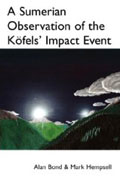
Get This Book From:
Amazon.com
Amazon.co.uk
“Life in the Universe:
A Beginner’s Guide
Astrobiology”
by
Lewis Dartnell
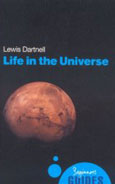
Get This Book From:
Amazon.com
Amazon.co.uk
“Planets and Life: The Emerging Science of Astrobiology”
by
Woodruff T. Sullivan III
(Author, Editor)
&
John Baross
(Editor)
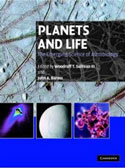
Get This Book From:
Amazon.com
Amazon.co.uk
“Complete Course in Astrobiology”
(Physics Textbook)
by
Gerda Horneck
(Editor)
&
Petra Rettberg
(Editor)
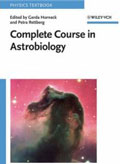
Get This Book From:
Amazon.com
Amazon.co.uk
“Astrochemistry: From Astronomy
to Astrobiology”
by
Andrew M. Shaw
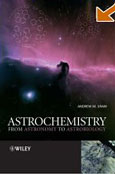
Get This Book From:
Amazon.com
Amazon.co.uk
“Fitness of the Cosmos for Life: Biochemistry and Fine-Tuning”
by
John Barrow
(Editor)
Simon Conway Morris
(Editor)
Stephen Freeland
(Editor)
Charles Harper
(Editor)
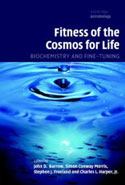
Get This Book From:
Amazon.com
Amazon.co.uk
“Astrobiology:
A Multi-disciplinary
Approach”
by
Jonathan Lunine
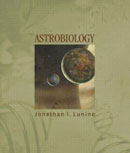
Get This Book From:
Amazon.com
Amazon.co.uk
“Binocular Astronomy”
by
Craig Crossen
&
Wil Tirion
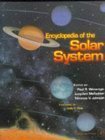
Get This Book From:
Amazon.com
Amazon.co.uk
“Comets II”
by
Michel C. Festou
H. Uwe Keller
Harold A. Weaver
(Editors)
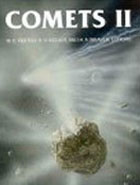
Get This Book From:
Amazon.com
Amazon.co.uk
“Cometary Science after Hale-Bopp, Volume I”
by
Hermann Bohnhardt
Michael Combi
Mark R. Kidger
Rita Schulz
(Editors)
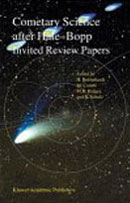
Get This Book From:
Amazon.com
Amazon.co.uk
“Comets: A Chronological History of Observation, Science, Myth
and Folklore”
by
Donald K. Yeomans 

Get This Book From:
Amazon.com
Amazon.co.uk
“A Sumerian Observation of the Kofels’ Impact Event”
by
Mark Hempsell
&
Alan Bond

Get This Book From:
Amazon.com
Amazon.co.uk
useful books from our
Astro-Archaeology
Bookshoppe
“A Little History of
Astro-Archaeology:
Stages in the Transformation
of a Heresy”
by
John Michell
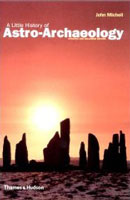
Get This Book From:
Amazon.com
Amazon.co.uk
“Stonehenge today is a battlefield, not only for police and festivalgoers at midsummer but also for rival camps of archaeologists, astronomers, and other researchers into the mysteries of prehistoric religion and science. Controversy flared up in 1963, when Gerald Hawkins made early use of the computer to identify Stonehenge as an observatory for the sun and moon and an instrument for predicting eclipses. Further studies of megalithic sites by Alexander Thom proved that many of them were also related to the seasonal positions of the heavenly bodies.
The study of astro-archaeology has now expanded worldwide, bringing new revelations about the mystical sciences of antiquity. This “little history” summarizes the issues involved in astro-archaeology, and illustrates its principal sites and personalities. Included are recent findings of British scientists, whose records of anomalous levels of natural energies at stone circles are in accordance with the magical reputations of such places in local folklore.”
NewBooks 2009
Astro-Archæology
&
Archæoastronomy
“Mysteries and Discoveries of Archaeoastronomy:
From Giza to Easter Island”
by
Giulio Magli
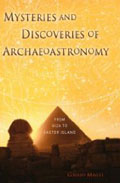
Get This Book From:
Amazon.com
Amazon.co.uk
“This complete, authoritative study of the growing discipline of Archaeoastronomy examines the role of astronomy in antiquity. Professor Giulio Magli provides a clear, up-to-date survey of current thinking on the motives of the ancients for building fabulous and mysterious monuments all over our planet. Was it an attempt to reproduce the sky on Earth, to bring down the power of the stars to where they could see it, worship it and use it?
The connecting thread is astronomy: Giulio Magli uses astronomy as a key to understanding our ancestors’ way of thinking. It is a challenge he likes to call ‘predicting the past’ – archaeology as a science is able to make predictions, like any other science, and to check them.
All of the astronomical achievements of the past are considered as a whole, in a comprehensive way that shows the depth and breadth of the thought behind them. In the past, the motives of the ancients – and particularly their scientific thought – have often been misconstrued, maligned or even dismissed.
In an ironic, provocative style, Professor Magli shows the limitations of orthodox archaeology in the face of astronomically-based artefacts and tries to understand what led the ancients to construct magnificent buildings such as the city of Teotihuacan in the Mexico Valley, the Ceremonial Centre of Chaco Canyon in the USA, the Avebury stone circle in Great Britain or the Great Pyramids in Egypt.
The book is divided into two parts. In the first, the reader is taken on an ideal ‘world tour’ of many wonderful and enigmatic places in almost every continent, in search of traces of astronomical knowledge and lore of the sky. In the second part, Giulio Magli uses the elements presented in the tour to show that the fundamental idea which led to the construction of the astronomically-related giant monuments was the foundation of power, a foundation which was exploited by ‘replicating’ the sky.
A possible interpretive model then emerges that is founded on the relationship the ancients had with “nature”, in the sense of everything that surrounded them, the cosmos. The numerous monumental astronomically aligned structures of the past then become interpretable as acts of will, expressions of power on the part of those who held it; the will to replicate the heavenly plane here on earth and to build sacred landscapes.”
“Canada’s Stonehenge: Astounding Archaeological Discoveries in Canada, England, and Wales”
by
Gordon Freeman
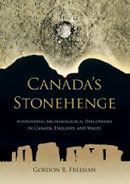
Get This Book From:
Amazon.com
Amazon.co.uk
“The discovery of a 5000-year-old Sun Temple and an ancient “time machine” – Stone Age calendar – in Canada led scientist Gordon Freeman to ground-breaking discoveries in Stonehenge. During fieldwork and research from 1986 to 2006, Freeman found striking similarities between the surface geometry of the two sites.
These similarities push back the boundaries of written history and have far-reaching implications for North American and European history.
Passion and science blend in this remarkable, readable book, as Freeman takes us along on his patient and exciting discovery of a 5000-year-old Temple in the plains of Alberta. What he finds at the Majorville Medicine Wheel in turn informs his convincing account of Stonehenge archaeoastronomy”
Astro-Archaeology
Classics
“Under Ancient Skies:
Ancient Astronomy and
Terrestrial Catastrophism”
Paul Dunbavin
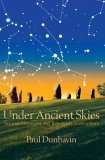
Get This Book From:
Amazon.com
Amazon.co.uk
“In all of the world’s myths and religions we find traditions of a Great Flood. There are stories too of a Golden Age: the antediluvian paradise that it destroyed. Might these be real memories of the ancient world? And how can we analyse the subject scientifically? The key to unlock these ancient myths lies in astronomy. “Under Ancient Skies” will examine the astronomical evidence for an ancient cataclysm and in the process will explore a number of related anomalies in prehistory, including: Was there a single great flood in human prehistory, or have there been many?
Could the workings of ancient calendars and the records of ancient eclipses give us clues about the Flood and the antediluvian world? Did the Celtic Druids use a calendar based on the orbit of Saturn; and is this the same antediluvian calendar as is described in Plato’s myth of Atlantis? Do Hindu, Chinese and Mayan cosmology myths recall the years after the Flood when our world wobbled on its axis?
Geologists have recently found the crater in Yucatan, where an asteroid impact destroyed the world of the dinosaurs. Scientists and astronomers have stopped dismissing the theory that a comet could have struck the Earth during prehistory – but any suggestion that a comet impact just a few thousand years ago might have caused the Biblical Flood, remains the last taboo. It is time for this barrier too to be washed away. If you read this book and you understand it then be warned – it may scare you!”
“East Asian Archaeoastronomy: Astronomical Observations of China, Japan and Korea”
Xu Zhentao, Jiang Yaotiao,
David W. Pankenier

Get This Book From:
Amazon.com
Amazon.co.uk
“Historical astronomical records can play an important role in modern research, especially in the case of ancient Chinese observational data: sunspot and aurora records are important for the study of solar variability; solar and lunar eclipse records for the study of the Earth’s rotation; records of Comet Hally for the study of orbital evolution; “guest star” records for the study of supernova remnants; planetary conjunction records for research in astronomical chronology.
In the past, Western scientists have not been able to exploit these valuable data fully because the original records were difficult to gather and interpret, and complete English translations have not been available. East-Asian Archaeoastronomy is the first comprehensive translation into English of such historical records for modern research.
The book also features an introduction to East Asian astronomy and offers guidance on how to use the records effectively. It will not only be a valuable research tool for astronomers but should also be of great interest to historians of China and Chinese science. Xu; Zhenoao Purple Mountin Observatory, Pankenier; W Department of Modern Foreign Language and Literatur, Yaotiao; Jiang Nanjing University , China.”
“Exploring Ancient Skies: An Encyclopedic Survey of Archaeoastronomy”
David Humiston Kelley
&
Eugene F. Milone
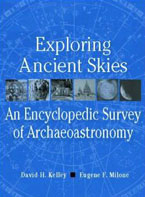
EU English Edition
“Exploring Ancient Skies brings together the methods of archaeology and the insights of modern astronomy to explore the science of astronomy as it was practiced in various cultures prior to the invention of the telescope. The book reviews an enormous and growing body of literature on the cultures of the ancient Mediterranean, the Far East, and the New World (particularly Mesoamerica), putting the ancient astronomical materials into their archaeological and cultural contexts.
The authors begin with an overview of the field and proceed to essential aspects of naked-eye astronomy, followed by an examination of specific cultures. The book concludes by taking into account the purposes of ancient astronomy: astrology, navigation, calendar regulation, and (not least) the understanding of our place and role in the universe.
Skies are recreated to display critical events as they would have appeared to ancient observers – events such as the supernova of 1054, the ‘lion horoscope’ or the ‘Star of Bethlehem.’Exploring Ancient Skies provides a comprehensive overview of the relationships between astronomy and other areas of human investigation. It will be useful as a reference for scholars and students in both astronomy and archaeology, and will be of compelling interest to readers who seek a broad understanding of our collective intellectual history.”
“Echoes of the Ancient Skies: The Astronomy of Lost Civilizations”
E.C. Krupp
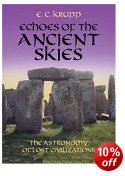
EU English Edition
“All over the world, through countless centuries, people have looked skyward for inspiration and guidance in their lives and activities. For most of the history of humankind, going back to the Stone Age, the sky has served as a tool. The regularity of the motions of celestial objects enabled our ancestors to orient themselves in time and space, satisfying their need for human order. How vast this heavenly influence was, and how awesome the human achievements it engendered were, are illuminated in this extraordinary work of investigation and discovery.
With hundreds of illustrations and photographs, Echoes of the Ancient Skies is a sweeping look at the world of archaeoastronomy from the prehistoric megaliths of Stonehenge, to the medicine wheels of North America, to the Aztec “Calendar Stone.”
The intriguing field of archaeoastronomy – the study of ancient peoples’ observation of the skies and its role in their cultural evolution – seeks to explore the “universal evidence that people have used astronomy as the model for injecting order and predictability on their behavior and on life.” Examining this universal behavior, Dr. E.C. Krupp takes the reader to sites throughout the world (most of which he has personally visited)–from Egypt, China, Babylonia, and Greece, to Turkey, Scotland, Wyoming, and Mexico. He interprets the significance of celestial observation and its relation to the earthly experiences of our ancestors, from practical applications of farming and the measurement of time to philosophical queries into our particular place within the universe.”
“The Chilling Stars 2nd Edition: A Cosmic View of Climate Change”
by
Henrik Svensmark
&
Nigel Calder
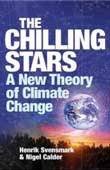
Get This Book From:
Amazon.com
Amazon.co.uk
“The authors explain their theory that sub-atomic particles from exploded stars have more effect on the climate than manmade CO2.
Their conclusion stems from Svensmark’s research which has shown the previously unsuspected role that cosmic rays play in creating clouds.
During the last 100 years cosmic rays became scarcer because unusually vigorous action by the Sun batted away many of them. Fewer cosmic rays meant fewer clouds – and a warmer world.
The theory, simply put here but explained in fascinating detail, emerges at a time of intense public and political concern about climate change.
Motivated only by their concern that science must be trustworthy, Svensmark and Calder invite their readers to put aside their preconceptions about manmade global warming and look afresh at the role of Nature in this hottest of world issues.”
“The Resilient Earth: Science, Global Warming and the Fate of Humanity”
by
Dr. Doug L. Hoffman
&
Allen Simmons
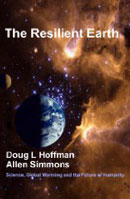
Get This Book From:
Amazon.com
Amazon.co.uk
“Heaven And Earth: Global Warming – The Missing Science”
by
Ian Plimer
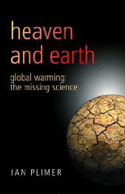
Get This Book From:
Amazon.com
Amazon.co.uk
“Binocular Astronomy”
by
Craig Crossen
&
Wil Tirion

Get This Book From:
Amazon.com
Amazon.co.uk
“Comets II”
by
Michel C. Festou
H. Uwe Keller
Harold A. Weaver
(Editors)

Get This Book From:
Amazon.com
Amazon.co.uk
“Fitness of the Cosmos for Life: Biochemistry and Fine-Tuning”
by
John Barrow
(Editor)
Simon Conway Morris
(Editor)
Stephen Freeland
(Editor)
Charles Harper
(Editor)

Get This Book From:
Amazon.com
Amazon.co.uk
|